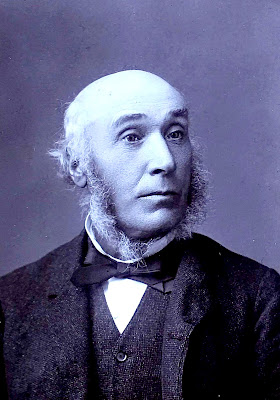SCOTTISH BORDERS
A village pub is always at the centre of life and here is the Red Lion in the Square at my home village of Earlston. Its records go back to 1814 - below an undated vintage postcard of the pub. Judging by the glimpse of the motor car - 1920s-1930s
John Newton, tenant and later owner of the Red Lion, serving for over 25 years
in the late 19th century.
in the late 19th century.
Still close to home, here is the market cross in the historic town of Melrose, famed for its 12th century ruined Abbey, its setting alongside the River Tweed and beneath the tripple Eildon Hills; and its success in Scotland in Bloom competitions.
HIDDEN STEP

Staffa lies 9
miles off the Isles of Mull and Iona in the Scottish Highlands. Its most famous feature is
Fingal's Cave, a large sea cave some 60 feet high. The sight of the rocks and the sound of the
sea inspired composer Felix Mendelssohn to capture his visit in 1829
in "The Hebrides Overture". Other famous visitors made the journey there - John Keats,
Sir Walter Scott, Joseph Turner and Robert Louis Stevenson. Queen
Victoria and Prince Albert were rowed into the cave on the royal barge
in 1847.
You can climb to the top of the island on some step, hidden in this gully.

A view from the top - quite a climb
with a rope to hold on to as a safely aid!

Marsden
Rock is a 100 foot sea stack which lies 100 yards off the cliff face, at South Shields in north east England. Steps were built into the rock and In 1903 several
choirs climbed onto the rock to perform a choral service. My husband
spent his childhood here, with the beach a favourite playground. In
a way this is an historic photograph, as in 1996 the arch collapsed,
splitting the rock into two stacks. The smaller stack was decreed unsafe
and demolished.
MORE ENGLISH STEPS

Our young daughter, c.1976 against the arched windows at Whitby Abbey perched high on the cliffs, overlooking the North Sea. The first monastery here, founded in about 657AD, became one of
the most important religious centres in the Anglo-Saxon world. The abbey was the inspiration for Bram Stoker's gothic novel, "Dracula", written in 1887.

***********
their family history and memories through photograph

Step HERE into more stories from other Sepia Saturday bloggers.




The market square marked with a raised post or statue must be primarily European as I can find few pictures of such things in the U.S. except for areas in some of the original colonies. Once folks began moving west and south, the "market square" pretty much disappeared. We still have open markets on occasion, but not necessarily in an officially marked place. Too bad because I like the look and idea of a predetermined market square. Oh well.
ReplyDeleteThis comment has been removed by a blog administrator.
ReplyDeleteI'm glad you identified the prompt as a market cross. I thought it was a bricked-over fountain. Like La Nightingail observed, it is an unfamiliar image in America. Love your photos - they always make me want to pack my bags and head to Scotland.
ReplyDelete(PS - every blog I've visited today has been hit by the same spammer. Did you know you can "delete forever" so that it doesn't even show in the comments? It's in your Dashboard.)
So glad to see images of nature and man made artifacts...stairs are helpful in getting to the top of things (a natural inclination of us humans.)
ReplyDeleteI've always been fascinated by Mendelssohn's trip to Scotland. I think he was the first composer who traveled for the pleasure of seeing a new place and then created music to describe it. He was also a talented artist and I think that sets him apart him too in visualizing music in a new way.
ReplyDeleteLike Wendy, I always love to see your photos and read your descriptions. Often the things pictured are unfamiliar sights here and, yes, they do make me want to make a trip to see in person!
ReplyDeleteA nice article, Sue - gives us all a look into your life. That is a sweet picture of your daughter at Whiby Abbey.
ReplyDeleteThank you for posting these pictures and including the history with them. Very enjoyable post!
ReplyDeleteWhat a beautiful place. I would love to visit sometime and explore.
ReplyDeleteI love reading about Scotland! But, I am afraid to say most of my knowledge is from reading the Outlander books by Diana Gabaldon, and watching the series on TV. I love discovering more about the places where they filmed. But, it is so much better to read about Scottish locations from a local who has lived there all her life. Would love to visit Scotland sometime!
ReplyDeleteWonderful photos Sue.
ReplyDeleteI learned about the Market Crosses on my trip to Scotland. My daughter took photos of them in every city and town! I’d love to go back!
Thank you all for your kind comments. I did not reslise that market crosses were an unfamiliar sight in the USA - surprising really when immigrants brought so many features from their homeland. Yes, I am lucky to live in such a beautiful” part of the world and enjoy sharing my pride with other bloggers and conveying something of our history. Like Mike, Mendelssohn one of my favourite composers and his Scottish Symphony always takes me back to holidays in the Western Isles.
ReplyDelete